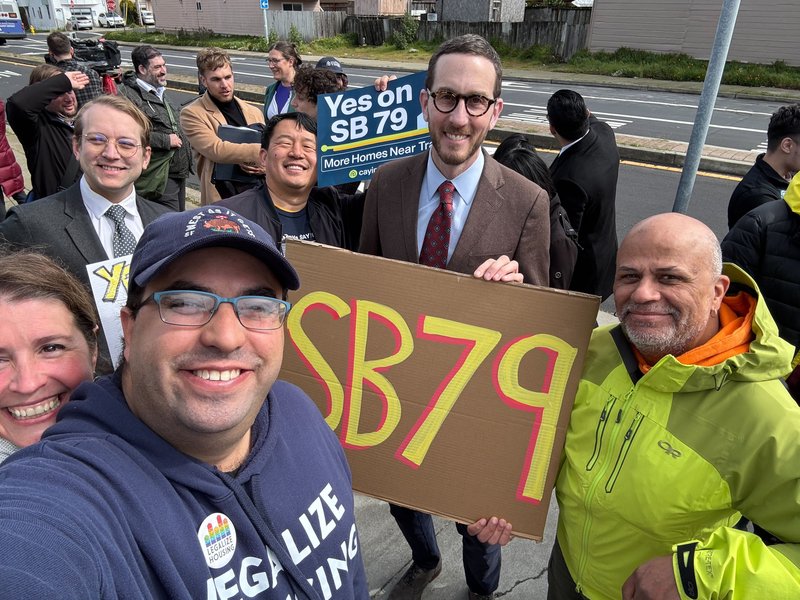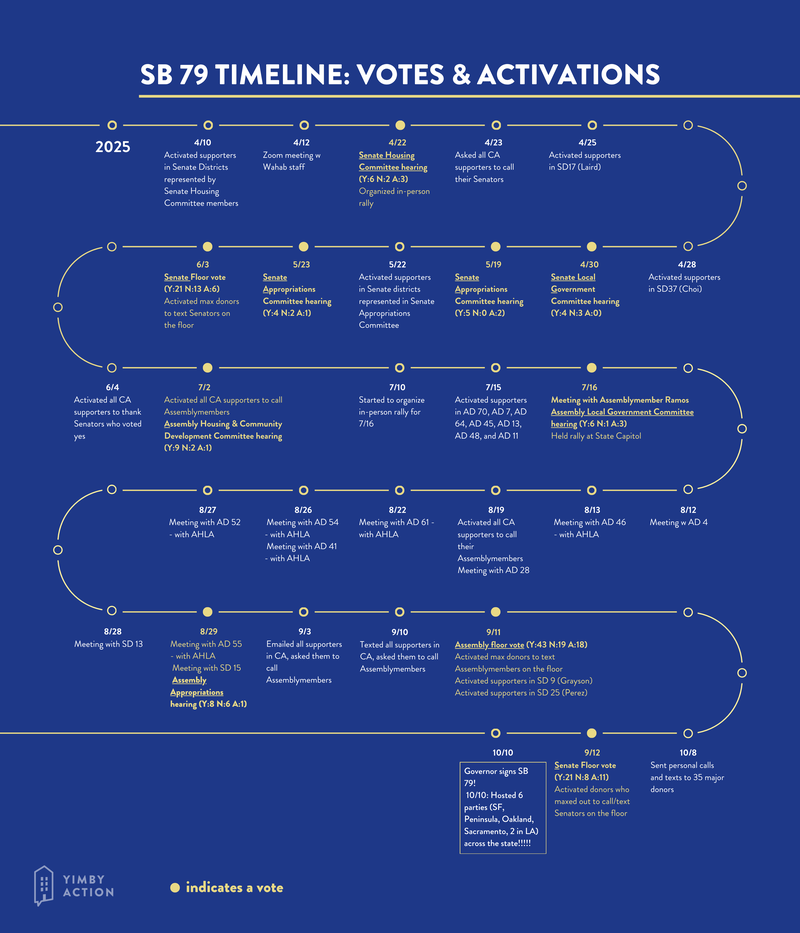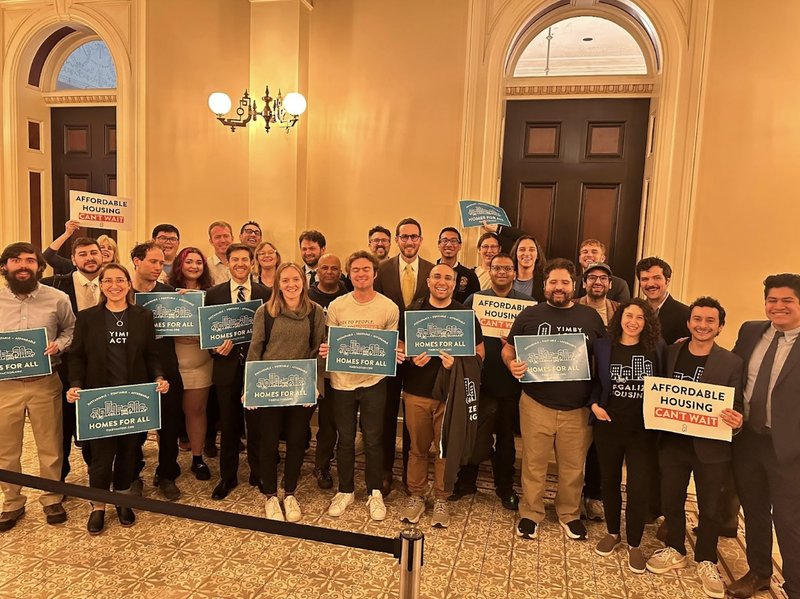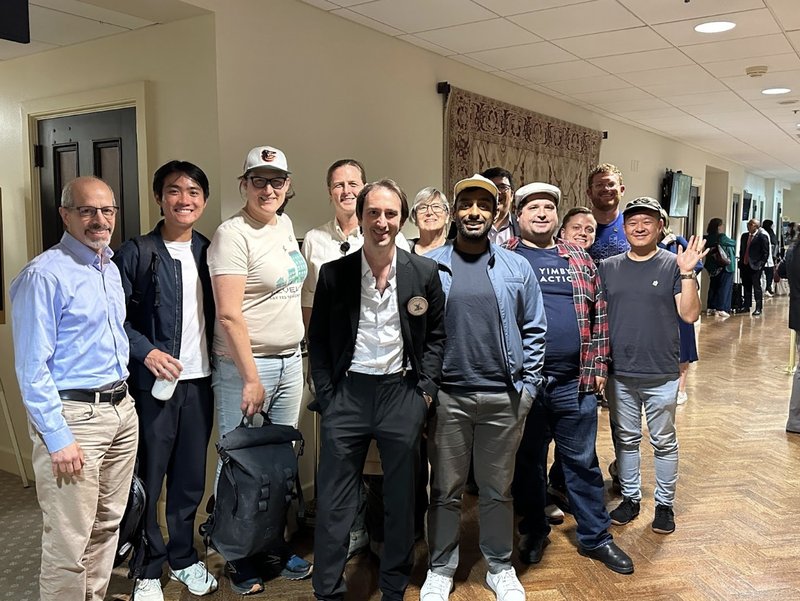California just took a big step toward legalizing housing near high-quality transit, but, as Jeremy Levine noted, “dragging Los Angeles kicking and screaming all the way.” This historic legislation passed with a host of caveats and by the skin of its teeth, making it a perfect case-study to examine both the growing drumbeat for housing reform and the remaining obstacles to reaching that goal.
SB 79 is the third iteration of Senator Scott Wiener’s concept of a state guardrails bill that would overrule local zoning laws that currently prevent apartment buildings from being built near trains and bus stops across the state. The dream began in 2018 when Senator Scott Wiener introduced SB 827, which died with a “resounding thud,” as stated by CalMatters. Though this first effort failed to earn a vote in the Senate, the movement was undeterred. In 2020, Senator Wiener introduced a second attempt, SB 50, but it also faltered, this time in a dramatic midnight vote on the Senate floor. And now, almost seven years later, a partial victory has been achieved, and the solution to the housing shortage is that much closer for us all.
But what made the difference this time around?
How The YIMBY Movement Helped Create Change
Three key factors tipped the balance:
- Steady growth in the YIMBY movement year after year in districts across the state.
- A larger coalition of co-sponsors and supporters.
- Better coordination of inside and outside games to leverage constituent pressure.
In 2018, there were only six YIMBY Action chapters across California, along with several other YIMBY groups. In 2025, YIMBY Action has grown to 20 chapters across the state, with increased membership, influential endorsements, and visible YIMBY activists in numerous Assembly districts. And other YIMBY groups like Abundant Housing LA, YIMBY Dems of San Diego and more are all going strong.
In 2018, media coverage noted that YIMBY supporters were dwarfed by NIMBY “enemies, enemies… a lot of enemies.” As the YIMBY movement has grown and the public narratives about how the housing shortage harms an ever-expanding community, it’s been easier and easier to convince more organizations to support major housing policy reform. Combined with a relentless negotiation strategy led by the tireless Senator Scott Wiener, this has resulted in a broader base of explicit supporters and a shrinking group of opposing organizations.

Finally, YIMBY organizations are upping their game with better communication between the inside game and the outside game. Strategic mobilizations coordinated across the pro-housing movement meant that constituent pressure played a key role in keeping legislators engaged. At critical junctures, pro-housing constituent pressure became the game-changing influence, mainly due to strong communication avenues between organizations like Housing Action Coalition, California YIMBY, YIMBY Action, and more.
Mobilizing constituent pressure is YIMBY Action’s core purpose, and everything we do feeds into that central goal. For the passage of SB 79, we managed a flurry of micro-campaigns across California, coordinating outreach directly from constituents to key legislators whose decisions would determine SB 79’s fate. Constituent pressure isn’t just about making noise — it’s about making the right noise, in the right rooms, at the right moments. By leveraging local voices, with insider intelligence, and rapid response coordination, the YIMBY coalition demonstrated how focused organizing can move transformative housing policy.
Building and Deploying Constituent Power
As organizations build out their people power, two strategic considerations must always be in mind:
- Local credibility matters. Legislators are moved most by in-district constituents who can connect policy to their district.
- Infrastructure is leverage. The ability to efficiently coordinate, track, and deploy advocates across multiple districts is what turns opportunity into victory.
These two insights have informed the YIMBY Action chapter model, giving us the flexibility for local organizers to create local brands that have a greater degree of influence with elected officials, while maintaining a tight communication network for coordinated mobilizations. National and statewide brands are useful on any number of other metrics, but unfortunately, many local elected officials will pay much more attention to locally branded groups advocating in their district.
While local brands and local leadership are ideal for building influence with elected officials, fragmentation can make it extremely challenging to mobilize that local power at the right time. Infrastructure in organizing is all about knowing where your power is, who is able to mobilize, and having the ability to get out the specific bat signals. This is where increased coordination between YIMBY organizations had a huge impact.
How YIMBY mobilizations Moved the Needle on SB 79

Targeted constituent pressure started even before the bill’s first hearing, when our South Bay YIMBY chapter met with Senator Wahab, the chair of the Senate Housing Committee. She made it clear she didn’t support the bill in its current form, and we’d have to convince other members of the committee in order to get it through. (Note: When the bill was amended in September, she signed on in support.)
With that knowledge, SB 79’s Senate Housing Committee hearing loomed large. We needed to pull out all the stops.
With 12 days’ notice, we organized 35 people from across California to attend the hearing from around the state, including as far away as Los Angeles. 35 people are a lot, given that people had to drop everything and we had to help arrange transportation, lodging, childcare, and work absences. But 35 is also a smaller number than you would think would matter for changing the fate of 2025’s most impactful housing bill. With our cadre of diverse, passionate YIMBY advocates from all corners of the state physically present in Sacramento, we moved the needle.
While the hearing ran on for hours, our advocates used the delay as an opportunity to rally additional support. After we set up camp in the halls of the Capitol, we all texted our friends and asked people back in our districts to call their Senators. Every minute before the vote, we were calling the Senators’ offices and urging other people to do the same, as we knew that if they heard from a flood of constituents, our messages would be relayed directly to the Senators.
During the hearing, we all participated in a “ditto” strategy, which is when multiple advocates in a row take the microphone to state their organization and share their position on the bill. Legislators are deeply affected by in-person testimony, and when we rallied young people, clearly not lobbyists, who were excited about the bill, it shifted the tone and energy of the room.
Although there are strict noise rules in the halls of the Capitol (along with staffers whose sole job, it seems, is to shush people who have travelled long distances to make their voices heard), the hall monitors allowed us a very subdued cheer when the bill passed with 6 votes – not a vote to spare. Senator Wiener exited the hearing room to a crowd of YIMBYs, most of whom could barely contain ourselves.

SB 79’s second hearing, at the Senate Local Government Committee, was just as daunting, as it was led by Senator Durazo, who, unlike Senator Wahab, never cast an “aye” vote for SB 79. A week before the hearing, we sent 9,807 activation emails asking our advocates to call her office. In addition, we asked 593 constituents to call Senators Laird and Choi, who were also key votes on that committee. (Laird voted yes, but Choi did not. It’s not a coincidence that we have a chapter in Laird’s district, but not Choi’s.) SB 79 passed Senator Durazo’s committee with the thinnest of margins – 4 to 3.
At this point, since the bill had survived two committees despite opposition from both chairs of those committees, we were riding high. Our partners informed us that the bill was likely to pass the Senate Appropriations Committee, so we set our sights on the Senate floor vote.
We emailed 22,256 YIMBYs in California, urging them to call their Senators a week before the floor vote, and focused our remaining energy on two swing votes in districts where we had already built a strong base of YIMBY support. We asked max donors to text their targeted electeds in the days leading up to the vote and on the Senate floor during the vote. This proved to be critical, as SB 79 passed the Senate floor by the thinnest possible margin – 21 to 13.
After this victory, we went back to work with two goals:
- Thank the Senators who already voted yes, since we would need their votes again if and when SB 79 passed the Assembly.
- Meet with the Assembly members to get their support.
On July 3rd, we drove over 2,500 phone calls into supportive Senators’ offices, thanking them for their votes. Then, throughout July and August, we hosted meetings with 14 legislators across the state, bringing as many constituents as we could, which ranged from 5 people to 40 (the office had to reserve their biggest conference room for us!).
For the July 16th Assembly Local Government hearing, we brought over a dozen folks to Sacramento, and the bill passed out of the committee with a vote of 6-1. We represented grassroots chapters all over California, with volunteers traveling from the Bay Area and beyond to show up for the bill in this committee hearing.

With the finish line in sight, we drove 9,844 calls to all the Assembly members, and we were relieved when it passed Assembly Appropriations with a vote of 8-6.
With the bill through all the committees, it was time for the big guns – we contacted all 22,769 people through text and email, asking them to contact their Assembly member & Senator. Our 226 volunteer leaders asked their friends, family, and networks to call their reps, expanding our reach by thousands. When we texted our list, we didn’t use a call tool; we put the Legislators’ phone numbers directly into the text, so the activists could call directly without filling out a form. Our priority was to create a seamless and simple outreach process, even if it meant we couldn’t always track how many people clicked through.
This tactic worked! On September 11th, SB 79 passed the Assembly with 43 votes, mainly because we repeated the strategy that won the Senate – activating thousands of constituents, prioritizing swing votes, and mobilizing key donors to call and text in the days and hours before the vote. We ended up mobilizing 10,303 new calls.
The next day, September 12th, SB 79 reached its final hurdle: the Senate needed to confirm support of final changes to the bill since June. In addition to all of our constituent activations, we leaned on the donors once again, asking them to text their Senators, even while they were working on the Senate floor. We also activated our donor and partner network to begin advocating with Governor Newsom, especially those with direct access.
Finally, on October 10th, the Governor signed SB 79, and the YIMBY Action team in California took a break from working. Just kidding! Feeding off the surge of energy from our members, we pulled together six impromptu celebrations around the state to gather and rejoice, while also deepening our relationships with our activists for the next campaign.
The Broader Significance
SB 79 represents more than a single policy win — it’s a proof of concept for the YIMBY model of advocacy. With modest resources, coordinated organizations achieved a landmark legislative victory by combining authentic local pressure with institutional precision.
Investment in infrastructure — data platforms, staff capacity, and local chapters — yields outsized returns. Each dollar supports both outreach and the systems that make outreach effective, including real-time coordination, easily digestible messaging, and sustained political credibility.
In an era where many housing reforms stall under the weight of complexity and opposition, SB 79’s success stands as evidence that smart advocacy backed by strong local networks can overcome entrenched barriers and deliver systemic change.

